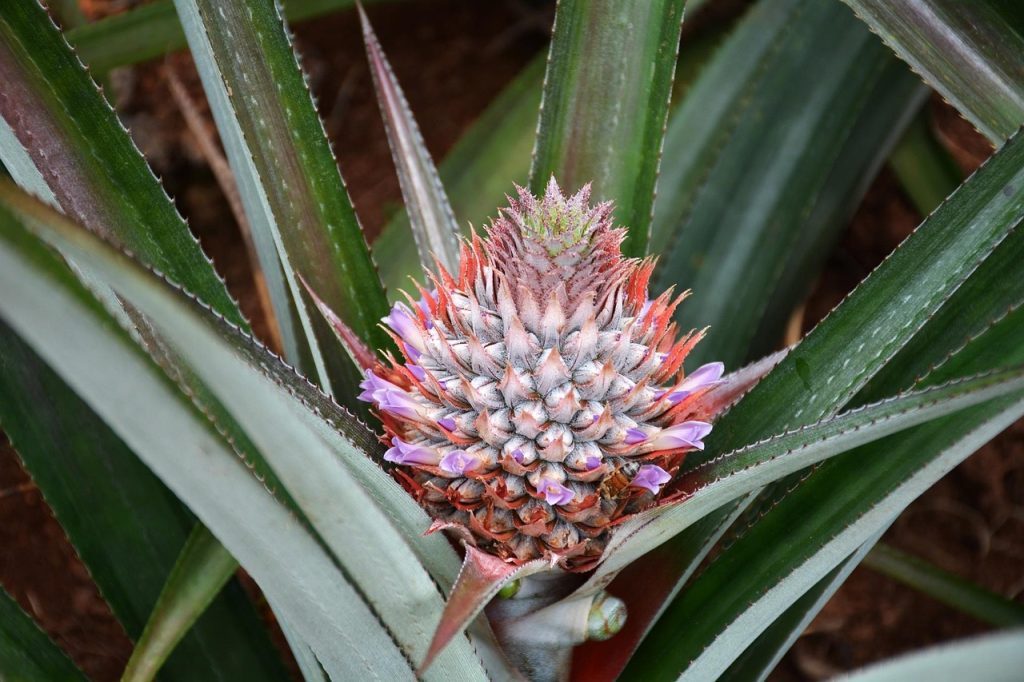Growing pineapples at home is exciting, especially when you see new shoots or suckers sprouting beside your main plant.
But then comes the big question: Should you leave that pineapple sucker to grow on the parent plant, or should you remove it?
The answer depends on your goal.
Let’s look at what happens in both cases, and what’s best for your plant’s health and your next harvest.
What Is a Pineapple Sucker?
Before deciding what to do, let’s understand what a pineapple sucker actually is.
A pineapple sucker is a small side shoot that grows between the leaves of the parent plant. It looks like a mini version of your pineapple plant and can eventually produce its own fruit.
These suckers usually appear after the main fruiting stage, once your pineapple has matured.
They’re part of how pineapples naturally multiply, kind of like a built-in recycling system.
There are different types of offshoots on a pineapple:
- Suckers (Ratoons): Grow from the base or between leaves.
- Slips: Grow just below the fruit.
- Crown: The leafy top of the fruit itself.
Each can grow into a new pineapple, but suckers tend to be the strongest and fastest growers.
What Happens If You Leave the Sucker on the Parent Plant?
If you leave your pineapple sucker attached to the parent plant, it will continue to grow naturally.
That sounds convenient, right? But here’s what really happens:
– Pros:
- Faster next fruiting cycle: The sucker can produce another pineapple faster than starting from scratch.
- Less work: You don’t have to replant or handle propagation.
- Continuous growth: The plant stays active instead of dying off after fruiting.
– Cons:
- Competition for nutrients: The parent plant and sucker share the same root system, which means they fight for water and nutrients.
- Smaller fruits: Because resources are divided, the next pineapple might be smaller or less sweet.
- Shorter lifespan: The parent plant may weaken and die sooner.
So, leaving the sucker attached can be convenient, but it might not give you the healthiest or biggest pineapples.
What Happens If You Remove the Sucker?
Now, let’s talk about the other option: removing the sucker and growing it separately.
When you remove a sucker properly and replant it, you’re basically giving it a fresh start.
This new plant can focus all its energy on growing strong roots and healthy fruit, without competing with the parent.
– Benefits of removing the sucker
- Healthier new plant: The sucker gets full access to nutrients from new soil.
- Bigger fruit yield: With its own root system, it can grow larger, sweeter pineapples.
- Sustainable propagation: You can grow multiple pineapples from one mother plant, great for home gardens.
– When should you remove it?
Wait until the sucker is around 8 to 12 inches tall with a few strong leaves.
Then, gently twist or cut it off near the base and let it dry for a day before planting in well-draining soil.
When You Should Leave the Sucker on the Parent Plant
Leaving a sucker attached can actually be a good choice in some situations.
Here’s when it makes sense:
- You want faster fruiting: If you’re not in a rush for huge pineapples and just want the next fruit cycle to start sooner, leave one healthy sucker.
- Your parent plant looks strong: If the parent is green, upright, and still firm, it can handle supporting another shoot.
- You prefer natural growth: If you like a low-maintenance, “let nature take its course” style of gardening, this option works fine.
Just make sure you remove extra suckers. One is enough, more than that, and they’ll crowd and weaken each other.
When You Should Not Leave the Sucker
You might want to remove the sucker instead if:
- The parent plant is old, weak, or drying out.
- You notice too many suckers competing for space.
- You want to control plant size or ensure larger fruit.
- You’re planning to start a new pineapple bed elsewhere.
In these cases, removing the sucker helps your garden stay cleaner and more productive.
It’s like pruning, you’re choosing quality over quantity.
Best Practice: Balance and Timing
The best approach is balance.
Most experienced gardeners leave one sucker attached for a second fruiting and remove the rest for propagation.
Here’s a simple rule:
- Leave one strong sucker if you want another pineapple on the same plant.
- Remove extra suckers to grow in pots or garden beds.
This way, you enjoy both – a quicker next fruit and a few new plants to expand your pineapple garden.
And pineapples grow slowly, so patience is part of the process. Whether you leave or remove your sucker, it’ll take 12 to 18 months for the next fruit to mature.
In Conclusion
So, should you leave your pineapple sucker to grow on the parent plant?
You can, but only if your parent plant is healthy and you don’t mind smaller fruits.
If you want stronger plants and larger pineapples, it’s better to remove the sucker and replant it.
The beauty of pineapples is that they keep giving. One plant can lead to many more, all from those little suckers.
